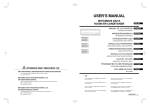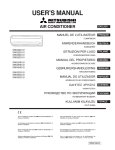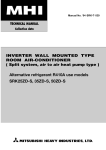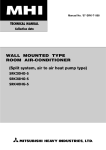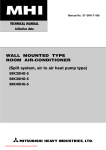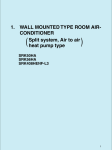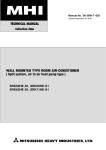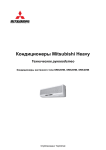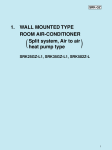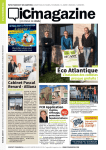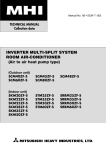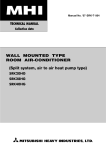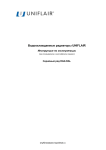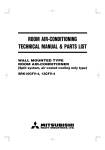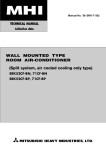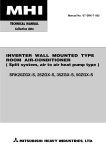Download Mitsubishi SRK20HD-S Specifications
Transcript
Кондиционеры Mitsubishi Heavy Техническое руководство Кондиционеры настенного типа SRK20HD-S, SRK28HD-S, SRK40HD-S, SRK20CD-S, SRK28CD-S, SRK40CD-S Опубликовано TopClimat CONTENTS 1. GENERAL INFORMATION .............................................................................. 1 1.1 Specific features ....................................................................................... 1 1.2 How to read the model name ................................................................... 1 2. SELECTION DATA........................................................................................... 2 2.1 Specifications ........................................................................................... 2 2.2 Range of usage & limitations .................................................................. 8 2.3 Exterior dimensions ................................................................................. 8 2.4 Piping system ........................................................................................... 10 2.5 Selection chart .......................................................................................... 11 3. ELECTRICAL DATA ........................................................................................ 12 3.1 Electrical wiring ........................................................................................ 12 4. OUTLINE OF OPERATION CONTROL BY MICROCOMPUTER ................... 14 4.1 Operation control function by remote control switch ........................... 14 4.2 Back-up switch ......................................................................................... 15 4.3 Power blackout auto restart function...................................................... 15 4.4 Flap control ............................................................................................... 16 4.5 Comfortable timer setting ........................................................................ 16 4.6 Outline of heating operation .................................................................... 17 4.7 Outline of cooling operation .................................................................... 20 4.8 Outline of dehumidifying operation ........................................................ 21 4.9 Automatic operation ................................................................................. 22 4.10 Outline of fan operation ........................................................................... 22 4.11 Protective control function ...................................................................... 23 5. APPLICATION DATA ....................................................................................... 25 5.1 Selection of location for installation ....................................................... 26 5.2 Installation of indoor unit ......................................................................... 27 5.3 Installation of outdoor unit ...................................................................... 29 5.4 Refrigerant piping ..................................................................................... 29 5.5 Test run ...................................................................................................... 31 5.6 Precautions for wireless remote controller installation and operation ................................................................................................... 32 6. MAINTENANCE DATA .................................................................................... 33 6.1 Trouble shooting ....................................................................................... 33 6.2 Servicing .................................................................................................... 38 - 1- Опубликовано TopClimat 1 GENERAL INFORMATION 1.1 Specific features The “Mitsubishi Daiya” room air-conditioner: SRK series are of split and wall mounted type and the unit consists of indoor unit and outdoor unit with refrigerant precharged in factory. The indoor unit is composed of room air cooling or heating equipment with operation control switch and the outdoor unit is composed of condensing unit with compressor. (1) Remote control flap The flap can be automatically controlled by operating wireless remote controller. ¡ Air scroll: Flap operation is automatically control. ¡ Swing: This will swing the flap up and down. ¡ Memory flap: Once the flap position is set, the unit memorizes the position and continues to operate at the same position from the next time. (2) Automatic Operation When the remote control switch is set on “auto( ) ”, it will either automatically decide operation mode such as cooling, heating and thermal dry, or operate in the operation mode before it has been turned to automatic control. (3) Self diagnosis function ¡ We are constantly trying to do better service to our customers by installing such judges that show abnormality of operation as follows. RUN lamp TIMER lamp ON 1 time flash Heat exchanger thermistor error 2 time flash Room temperature thermistor error 6 time flash Indoor fan motor error RUN lamp keeps flashing RUN lamp ON TIMER lamp Outdoor (LED) 1 time flash OFF 2 time flash OFF 4 time flash OFF 1 time flash 1 time flash Current cut 2 time flash 2 time flash Outdoor unit error 5 time flash 5 time flash Compressor overheat 6 time flash 6 time flash Serial signal transmission error 1.2 How to read the model name Example : SR K 40 H D - S R410A models Series No. H: Heat pump type C: Cooling only type Product capacity Wall mounted type Split type room air-conditioner - 1- Опубликовано TopClimat Outdoor temperature thermistor error Outdoor unit heat exchanger thermistor error Discharge pipe thermistor error 2 SELECTION DATA 2.1 Specifications Model SRK20HD-S (Indoor unit) SRC20HD-S (Outdoor unit) Model SRK20HD-S Item Refrigerant piping Operation data(1) Cooling capacity(1) Heating capacity(1) Power source Cooling input Running current (Cooling) Heating input Running current (Heating) Inrush current COP sound level Cooling Power level Noise level sound level Heating Power level Exterior dimensions Height × Width × Depth Color Net weight Refrigerant equipment Compressor type & Q’ty Motor Starting method Heat exchanger Refrigerant control Refrigerant(3) Refrigerant oil Deice control Air handling equipment Fan type & Q’ty Motor (Cooling) Air flow (at High) (Heating) Air filter, Q’ty Shock & vibration absorber Electric heater Operation control Operation switch Room temperature control Pilot lamp Safety equipment O.D Connecting method Attached length of piping W W SRC20HD-S 2050 2200 1 Phase, 220/230/240V, 50Hz 0.63 3.1/3.0/2.9 0.6 3.0/2.9/2.8 18.9 Cooling: 3.21 Heating: 3.61 Hi 34, Me 28, Lo 26 46 dB 52 Hi 34, Me 31, Lo 27 60 46 52 60 mm 250 × 815 × 249 540 × 720 × 290 kg Cool white 9.0 Stucco white 32 – RM-B5077MNE4 (Rotary type) × 1 – – 0.65 Line starting kW A kW A A kW kg R R410A W CMM Louver fins & inner grooved tubing Capillary tubes + Electronic expansion valve 0.9 (Pre-Charged up to the piping length of 15m) 0.35 (MA68) MC control Tangential fan × 1 Propeller fan × 1 14 7.5 7.5 Polypropylene net (washable) × 2 – – 12 26 26 – Cushion rubber (for compressor) – Wireless-Remote controller – MC. Thermostat – RUN (Green), TIMER (Yellow), HI POWER (Green), ECONO (Orange) Compressor: Overheat protection, overcurrent protection, Serial signal error protection, Indoor fan motor error protection, Frost protection mm (in) Insulation Drain hose Power source cord Size × Core number Connecting method Accessories (included) Optional parts Connection wiring Liquid line: φ6.35 (1/4″) Gas line: φ9.52 (3/8″) Flare connecting Liquid line: 0.4 m – Gas line : 0.33 m Necessary (Both sides) Connectable 2.5 m (3 cores with Earth) 1.5 mm2 × 4 cores (Including earth cable) Terminal block (Screw fixing type) Mounting kit – Notes (1) The data are measured at the following conditions. Item Operation Cooling Heating Indoor air temperature DB WB 27ºC 19ºC 20ºC – Outdoor air temperature DB WB 35ºC 24ºC 7ºC 6ºC The piping length is 7.5m. (2) The operation data are applied to the 220/230/240V districts respectively. (3) The refrigerant quantity to be charged includes the refrigerant in 15 m connecting piping. (Purging is not required even in the short piping.) - 2- Опубликовано TopClimat Standards ISO-T1, JIS C9612 ISO-T1, JIS C9612 Model SRK28HD-S (Indoor unit) SRC28HD-S (Outdoor unit) Model SRK28HD-S Item Operation data(1) Cooling capacity(1) Heating capacity(1) Power source Cooling input Running current (Cooling) Heating input Running current (Heating) Inrush current COP Cooling sound level Power level Heating sound level Power level Noise level Exterior dimensions Height × Width × Depth Color Net weight Refrigerant equipment Compressor type & Q’ty Motor Starting method Heat exchanger Refrigerant control Refrigerant(3) Refrigerant oil Deice control Air handling equipment Fan type & Q’ty Motor Air flow (at High) W W kW A kW A A Hi 39, Me 33, Lo 30 55 46 60 Hi 40, Me 33, Lo 29 56 46 60 mm 250 × 815 × 249 540 × 720 × 290 kg Cool white 9.0 Stucco white 32 – 5PS102DAB [Rotary type] × 1 – – 0.7 Line starting dB kg R R410A W CMM Air filter, Q’ty Shock & vibration absorber Electric heater Operation control Operation switch Room temperature control Pilot lamp Safety equipment Refrigerant piping 2550 2800 1 Phase, 220/230/240V, 50Hz 0.79 3.9/3.7/3.5 0.77 3.7/3.5/3.3 17.2 Cooling: 3.21 Heating: 3.61 kW (Cooling) (Heating) SRC28HD-S Louver fins & inner grooved tubing Capillary tubes + Electronic expansion valve 0.9 (Pre-Charged up to the piping length of 15m) 0.35 (RB68A) MC control Tangential fan × 1 Propeller fan × 1 14 8.0 8.5 Polypropylene net (washable) × 2 – – 15 30 30 – Cushion rubber (for compressor) – Wireless-Remote controller – MC. Thermostat – RUN (Green), TIMER (Yellow), HI POWER (Green), ECONO (Orange) Compressor: Overheat protection, overcurrent protection, Serial signal error protection, Indoor fan motor error protection, Frost protection O.D Connecting method Attached length of piping mm (in) Insulation Drain hose Power source cord Size × Core number Connecting method Accessories (included) Optional parts Connection wiring Liquid line: φ6.35 (1/4″) Gas line: φ9.52 (3/8″) Flare connecting Liquid line: 0.4 m – Gas line : 0.33 m Necessary (Both sides) Connectable 2.5 m (3 cores with Earth) 1.5 mm2 × 4 cores (Including earth cable) Terminal block (Screw fixing type) Mounting kit – Notes (1) The data are measured at the following conditions. Item Operation Cooling Heating Indoor air temperature DB WB 27ºC 19ºC 20ºC – Outdoor air temperature DB WB 35ºC 24ºC 7ºC 6ºC The piping length is 7.5m. (2) The operation data are applied to the 220/230/240V districts respectively. (3) The refrigerant quantity to be charged includes the refrigerant in 15 m connecting piping. (Purging is not required even in the short piping.) - 3- Опубликовано TopClimat Standards ISO-T1, JIS C9612 ISO-T1, JIS C9612 Model SRK40HD-S (Indoor unit) SRC40HD-S (Outdoor unit) Model SRK40HD-S Item Operation data(1) Cooling capacity(1) Heating capacity(1) Power source Cooling input Running current (Cooling) Heating input Running current (Heating) Inrush current COP Cooling sound level Power level Heating sound level Power level Noise level Exterior dimensions Height × Width × Depth Color Net weight Refrigerant equipment Compressor type & Q’ty Motor Starting method Heat exchanger Refrigerant control Refrigerant(3) Refrigerant oil Deice control Air handling equipment Fan type & Q’ty Motor Air flow (at High) W W kW A kW A A Hi 40, Me 38, Lo 34 56 49 63 Hi 41, Me 38, Lo 34 57 50 64 mm 250 × 815 × 249 640 × 850 × 290 kg Cool white 9.0 Stucco white 41 – 5KS150DBB [Rotary type] × 1 – – 1.1 Line starting dB kg R R410A W CMM Air filter, Q’ty Shock & vibration absorber Electric heater Operation control Operation switch Room temperature control Pilot lamp Safety equipment Refrigerant piping 3600 4000 1 Phase, 220/230/240V, 50Hz 1.12 5.3/5.1/4.9 1.16 5.5/5.3/5.1 25.2 Cooling: 3.21 Heating: 3.42 kW (Cooling) (Heating) SRC40HD-S Louver fins & inner grooved tubing Capillary tubes + Electronic expansion valve 1.17 (Pre-Charged up to the piping length of 15m) 0.43 (RB68A) MC control Tangential fan × 1 Propeller fan × 1 14 9.0 9.5 Polypropylene net (washable) × 2 – – 35 38 38 – Cushion rubber (for compressor) – Wireless-Remote controller – MC. Thermostat – RUN (Green), TIMER (Yellow), HI POWER (Green), ECONO (Orange) Compressor: Overheat protection, overcurrent protection, Serial signal error protection, Indoor fan motor error protection, Frost protection O.D Connecting method Attached length of piping mm (in) Insulation Drain hose Power source cord Size × Core number Connecting method Accessories (included) Optional parts Connection wiring Liquid line: φ6.35 (1/4″) Gas line: φ12.7 (1/2″) Flare connecting Liquid line: 0.4 m – Gas line : 0.33 m Necessary (Both sides) Connectable 2.5 m (3 cores with Earth) 1.5 mm2 × 4 cores (Including earth cable) Terminal block (Screw fixing type) Mounting kit – Notes (1) The data are measured at the following conditions. Item Operation Cooling Heating Indoor air temperature DB WB 27ºC 19ºC 20ºC – Outdoor air temperature DB WB 35ºC 24ºC 7ºC 6ºC The piping length is 7.5m. (2) The operation data are applied to the 220/230/240V districts respectively. (3) The refrigerant quantity to be charged includes the refrigerant in 15 m connecting piping. (Purging is not required even in the short piping.) - 4- Опубликовано TopClimat Standards ISO-T1, JIS C9612 ISO-T1, JIS C9612 Model SRK20CD-S (Indoor unit) SRC20CD-S (Outdoor unit) Model SRK20CD-S Item (1) Operation data(1) Cooling capacity Power source Cooling input Running current (Cooling) Inrush current COP Noise level Cooling Refrigerant piping Exterior dimensions Height × Width × Depth Color Net weight Refrigerant equipment Compressor type & Q’ty Motor Starting method Heat exchanger Refrigerant control Refrigerant(3) Refrigerant oil Deice control Air handling equipment Fan type & Q’ty Motor Air flow (at High) Air filter, Q’ty Shock & vibration absorber Electric heater Operation control Operation switch Room temperature control Pilot lamp Safety equipment sound level Power level W 2050 1 Phase, 220/230/240V, 50Hz 0.63 3.1/3.0/2.9 18.9 Cooling: 3.21 kW A A dB Hi 34, Me 28, Lo 26 52 46 60 mm 250 × 815 × 249 540 × 720 × 290 kg Cool white 9.0 Stucco white 32 – RM-B5077MNE4 (Rotary type) × 1 – – 0.65 Line starting kW kg R (Cooling) O.D Connecting method Attached length of piping Insulation Drain hose Power source cord Size × Core number Connecting method Accessories (included) Optional parts Connection wiring SRC20CD-S W CMM R410A Louver fins & inner grooved tubing Capillary tubes + Electronic expansion valve 0.9 (Pre-Charged up to the piping length of 15m) 0.35 (MA68) MC control Tangential fan × 1 Propeller fan × 1 14 7.5 Polypropylene net (washable) × 2 – – 12 26 – Cushion rubber (for compressor) – Wireless-Remote controller – MC. Thermostat – RUN (Green), TIMER (Yellow), HI POWER (Green), ECONO (Orange) Compressor: Overheat protection, overcurrent protection, Serial signal error protection, Indoor fan motor error protection, Frost protection mm (in) Liquid line: φ6.35 (1/4″) Gas line: φ9.52 (3/8″) Flare connecting Liquid line: 0.4 m – Gas line : 0.33 m Necessary (Both sides) Connectable 2.5 m (3 cores with Earth) 1.5 mm2 × 4 cores (Including earth cable) Terminal block (Screw fixing type) Mounting kit – Notes (1) The data are measured at the following conditions. Item Indoor air temperature Operation DB WB Cooling 27ºC 19ºC Outdoor air temperature DB WB 35ºC 24ºC The piping length is 7.5m. (2) The operation data are applied to the 220/230/240V districts respectively. (3) The refrigerant quantity to be charged includes the refrigerant in 15 m connecting piping. (Purging is not required even in the short piping.) - 5- Опубликовано TopClimat Standards ISO-T1, JIS C9612 Model SRK28CD-S (Indoor unit) SRC28CD-S (Outdoor unit) Model SRK28CD-S Item Operation data(1) Cooling capacity(1) Power source Cooling input Running current (Cooling) Inrush current COP Noise level Cooling Refrigerant piping Exterior dimensions Height × Width × Depth Color Net weight Refrigerant equipment Compressor type & Q’ty Motor Starting method Heat exchanger Refrigerant control Refrigerant(3) Refrigerant oil Deice control Air handling equipment Fan type & Q’ty Motor Air flow (at High) Air filter, Q’ty Shock & vibration absorber Electric heater Operation control Operation switch Room temperature control Pilot lamp Safety equipment sound level Power level W 2550 1 Phase, 220/230/240V, 50Hz 0.79 3.9/3.7/3.5 17.2 Cooling: 3.21 kW A A dB Hi 39, Me 33, Lo 30 55 46 60 mm 250 × 815 × 249 540 × 720 × 290 kg Cool white 9.0 Stucco white 32 – 5PS102DAB [Rotary type] × 1 – – 0.7 Line starting kW kg R (Cooling) O.D Connecting method Attached length of piping Insulation Drain hose Power source cord Size × Core number Connecting method Accessories (included) Optional parts Connection wiring SRC28CD-S R410A W CMM Louver fins & inner grooved tubing Capillary tubes + Electronic expansion valve 0.9 (Pre-Charged up to the piping length of 15m) 0.35 (RB68A) MC control Tangential fan × 1 Propeller fan × 1 14 8.0 Polypropylene net (washable) × 2 – – 15 30 – Cushion rubber (for compressor) – Wireless-Remote controller – MC. Thermostat – RUN (Green), TIMER (Yellow), HI POWER (Green), ECONO (Orange) mm (in) Compressor: Overheat protection, overcurrent protection, Serial signal error protection, Indoor fan motor error protection, Frost protection Liquid line: φ6.35 (1/4″) Gas line: φ9.52 (3/8″) Flare connecting Liquid line: 0.4 m – Gas line : 0.33 m Necessary (Both sides) Connectable 2.5 m (3 cores with Earth) 1.5 mm2 × 4 cores (Including earth cable) Terminal block (Screw fixing type) Mounting kit – Notes (1) The data are measured at the following conditions. Item Operation Cooling The piping length is 7.5m. Indoor air temperature DB WB 27ºC 19ºC Outdoor air temperature DB WB 35ºC 24ºC (2) The operation data are applied to the 220/230/240V districts respectively. (3) The refrigerant quantity to be charged includes the refrigerant in 15 m connecting piping. (Purging is not required even in the short piping.) - 6- Опубликовано TopClimat Standards ISO-T1, JIS C9612 Model SRK40CD-S (Indoor unit) SRC40CD-S (Outdoor unit) Model SRK40CD-S Item Operation data(1) Cooling capacity(1) Power source Cooling input Running current (Cooling) Inrush current COP Noise level Cooling Refrigerant piping Exterior dimensions Height × Width × Depth Color Net weight Refrigerant equipment Compressor type & Q’ty Motor Starting method Heat exchanger Refrigerant control Refrigerant(3) Refrigerant oil Deice control Air handling equipment Fan type & Q’ty Motor Air flow (at High) Air filter, Q’ty Shock & vibration absorber Electric heater Operation control Operation switch Room temperature control Pilot lamp Safety equipment sound level Power level W 3600 1 Phase, 220/230/240V, 50Hz 1.12 5.3/5.1/4.9 25.2 Cooling: 3.21 kW A A dB Hi 40, Me 38, Lo 34 56 49 63 mm 250 × 815 × 249 640 × 850 × 290 kg Cool white 9.0 Stucco white 41 – 5KS150DBB [Rotary type] × 1 – – 1.1 Line starting kW kg R (Cooling) O.D Connecting method Attached length of piping Insulation Drain hose Power source cord Size × Core number Connecting method Accessories (included) Optional parts Connection wiring SRC40CD-S W CMM R410A Louver fins & inner grooved tubing Capillary tubes + Electronic expansion valve 1.17 (Pre-Charged up to the piping length of 15m) 0.43 (RB68A) MC control Tangential fan × 1 Propeller fan × 1 14 9.0 Polypropylene net (washable) × 2 – – 35 38 – Cushion rubber (for compressor) – Wireless-Remote controller – MC. Thermostat – RUN (Green), TIMER (Yellow), HI POWER (Green), ECONO (Orange) Compressor: Overheat protection, overcurrent protection, Serial signal error protection, Indoor fan motor error protection, Frost protection mm (in) Liquid line: φ6.35 (1/4″) Gas line: φ12.7 (1/2″) Flare connecting Liquid line: 0.4 m – Gas line : 0.33 m Necessary (Both sides) Connectable 2.5 m (3 cores with Earth) 1.5 mm2 × 4 cores (Including earth cable) Terminal block (Screw fixing type) Mounting kit – Notes (1) The data are measured at the following conditions. Item Indoor air temperature Operation DB WB Cooling 27ºC 19ºC Outdoor air temperature DB WB 35ºC 24ºC The piping length is 7.5m. (2) The operation data are applied to the 220/230/240V districts respectively. (3) The refrigerant quantity to be charged includes the refrigerant in 15 m connecting piping. (Purging is not required even in the short piping.) - 7- Опубликовано TopClimat Standards ISO-T1, JIS C9612 2.2 Range of usage & limitations Models All models Item Indoor return air temperature (Upper, lower limits) Refer to the selection chart Outdoor air temperature (Upper, lower limits) Refrigerant line (one way) length Max. 15m Vertical height difference between outdoor unit and indoor unit Max. 10m (Outdoor unit is higher) Max. 10m (Outdoor unit is lower) Rating ± 10% Power source voltage Voltage at starting Min. 85% of rating Frequency of ON-OFF cycle Max. 10 times/h ON and OFF interval Max. 3 minutes 2.3 Exterior dimensions (1) Indoor unit Models All models Unit: mm A 249 815 3 9 250 60 Piping hole right(left) Terminal block 117.5 580 450 216.5 216.5 236.1 44.5 175 8.2 47.2 42.7 148.5 450 148.5 45 117.5 ) 45 ( 60 60 Piping for Liquid 465.1 (ø6.35) Drain hose 540 (ø16) Piping hole (ø65) Piping hole (ø65) VIEW A - 8- Опубликовано TopClimat 14.5 45 Piping for Gas 67.5 20.28: ø9.52 40: ø12.7 397.1 53.5 5.7 44.5 788 5 (2) Outdoor unit Models SRC20HD-S, 28HD-S, 20CD-S, 28CD-S Unit: mm Drain holes 50 264.5 404.5 17.8 510 71 340 14 47.4 290 312.5 42.6 13.5 12 139 2-16 x12 720 Terminal block 61.9 39.7 99.9 40° 40° 14.4 Service valve (Liquid) Flare connecting ø6.35 (1/4") 33.3 540 139.3 Service valve (Gas) Flare connecting ø9.52 (3/8") Models SRC40HD-S, 40CD-S Drain hole 50 12 14 49.6 314 290 43.5 12 476 203.1 328 286.4 510 Elogated hole (2-12 x16) 136.9 850 Terminal block 640 124 34.6 15 - 9- Опубликовано TopClimat 20˚ 20˚ 100.3 42.7 Ground terminal Service valve (Liquide) ø6.35 (1/4'') Service valve (Gas) ø12.7 (1/2'') 2.4 Piping system Models SRK20HD-S, 28HD-S, 40HD-S Indoor unit Outdoor unit Cooling cycle Heating cycle Flare connecting ( Service valve (Gas) Piping (Gas) 20, 28 : ø9.52 40 : ø12.7 ) Outdoor air temp. thermistor Check joint 4 way valve Accumulator Room temp. thermistor Discharge temp. thermistor Heat exchanger thermistor Heat exchanger Heat exchanger Compressor Piping (Liquid) ø6.35 Heat exchanger thermistor Service valve (Liquid) Capillary tube Capillary tube Strainer Flare connecting Electronic expansion valve Models SRK20CD-S, 28CD-S Indoor unit Outdoor unit Flare connecting Piping (Gas) ø9.52 Cooling cycle Outdoor air temp. thermistor Service valve (Gas) Check joint Accumulator Room temp. thermistor Discharge temp. thermistor Heat exchanger thermistor Heat exchanger Heat exchanger Compressor Piping (Liquid) ø6.35 Heat exchanger thermistor Service valve (Liquid) Capillary tube Capillary tube Strainer Flare connecting Electronic expansion valve Model SRK40CD-S Indoor unit Outdoor unit Flare connecting Piping (Gas) ø12.7 Cooling cycle Outdoor air temp. thermistor Service valve (Gas) Check joint Accumulator Room temp. thermistor Discharge temp. thermistor Heat exchanger thermistor Heat exchanger Heat exchanger Compressor Piping (Liquid) ø6.35 Service valve (Liquid) Capillary tube Electronic expansion valve Flare connecting - 10 - Опубликовано TopClimat Heat exchanger thermistor 2.5 Selection chart Correct the cooling and heating capacity in accordance with the conditions as follows. The net cooling and heating capacity can be obtained in the following way. Net capacity = Capacity shown on specification ✕ Correction factors as follows. (1) Coefficient of cooling and heating capacity in relation to temperatures Coefficient of cooling & Heating capacity in relation to temperature 1.3 1.2 Cooling 1.1 1.0 Heating 0.9 0.8 0.7 0.6 Outdoor air D.B. temperature °C D.B. Cooling operation Applicable range 43 40 35 30 25 20 15 24 14 16 18 20 22 Indoor air D.B. temperature °C D.B. Heating operation Indoor air W.B. temperature °C W.B. ISO-T1 Standard Condition 27 25 20 15 10 20 -10 -5 0 5 10 15 Outdoor air W.B. temperature °C W.B. ISO-T1 Standard Condition (2) Correction of cooling and heating capacity in relation to one way length of refrigerant piping It is necessary to correct the cooling and heating capacity in relation to the one way piping length between the indoor and outdoor units. Piping length [m] 7 10 15 Cooling 1.0 0.99 0.975 Heating 1.0 1.0 1.0 (3) Correction relative to frosting on outdoor heat exchanger during heating In additions to the foregoing corrections (1), (2) the heating capacity needs to be adjusted also with respect to the frosting on the outdoor heat exchanger. Air inlet temperature of outdoor unit in ˚CWB -10 -9 -7 -5 -3 -1 1 3 5 Adjustment coefficient 0.95 0.94 0.93 0.91 0.88 0.86 0.87 0.92 1.00 How to obtain the cooling and heating capacity Example : The net cooling capacity of the model SRK40HD-S with the piping length of 15m, indoor wet-bulb temperature at 19.0˚C and outdoor dry-bulb temperature 35˚C is Net cooling capacity = 3600 ✕ SRK40HD-S - 0.975 ✕ Length 15m 11 - Опубликовано TopClimat 1.0 = Factor by air temperatures 3510 w BR WH - RD J CC G 2 12 - 52C 1 CNG Symbol Th1 Th2 Th4 Th5 Th6 Tr CFO 1 Y/GN F (250V 3.15A) D.S Th1 52X3 Parts name Th5 Symbol ZNR 20S 52C DS 52X1-3 EEV 51C Printed circuit board Th4 Th2 Parts name Varistor 4 way valve (coil) Magnetic contactor Diode stack Auxiliary relay Electronic expansion valve Motor Protector for CM Опубликовано TopClimat 52X1 CNE Th6 Room temp. thermistor Heat exchanger thermistor (Indoor unit) Heat exchanger thermistor (Outdoor unit) Outdoor air temp. thermistor Discharge temp. thermistor Transformer 1 3 EEV Display Wireless R-Amp ZNR 52X2 CNB 20S Meaning of marks Parts name CM1 3 CNM Capacitor for FMI Compressor motor Fuse Fan motor (Indoor) Fan motor (Outdoor) Flap motor BK 5 FMo ZNR CNE CFI CM F FMI FMo SM 51C CNU Printed circuit board Symbol G1 J 52X1 F (250V 3.15A) IC8 Color symbol BK Black BR Brown RD Red LB Light blue WH White Y/GN Yellow/Green N WH CM2 CM 3 CNW SM L RD 1 WH 2 1 Y/GN RD CFI 52C BK N 52C-3 CNU 1 5 3 CNB 52C-4 CNC BR WH HEAT EXCHANGER 2/N BK BK WH 3 RD Tr 3 WH LB CNG 52X2 52X3 ELECTRICAL DATA RD BR FMI TB Y/GN 3 TB Y/GN LB 3.1 Electrical wiring Outdoor unit Indoor unit Models SRK20HD-S, 28HD-S, 40HD-S Power source 1 Phase 220/230/240V 50Hz Outdoor unit Indoor unit TB Y/GN LB BR WH - RD J G CC 2 G1 J 51C 1 BK CM1 52X1 F (250V 3.15A) 13 - IC8 52C CNU ZNR CFO 1 F (250V 3.15A) 5 FMo ZNR D.S 3 Printed circuit board 52X2 CNM SM CNG CNE Color symbol BK Black BR Brown RD Red LB Light blue WH White Y/GN Yellow/Green Wireless R-Amp Th1 Parts name Capacitor for FMI Compressor motor Fuse Fan motor (Indoor) Fan motor (Outdoor) Flap motor Symbol Th1 Th2 Th4 Th5 Th6 Tr Th5 Th6 Parts name Room temp. thermistor Heat exchanger thermistor (Indoor unit) Heat exchanger thermistor (Outdoor unit) Outdoor air temp. thermistor Discharge temp. thermistor Transformer Symbol ZNR 52C DS 52X1-2 EEV 51C Printed circuit board Th4 Th2 Parts name Varistor Magnetic contactor Diode stack Auxiliary relay Electronic expansion valve Motor Protector for CM Опубликовано TopClimat 52X1 CNE EEV Display Meaning of marks CFI CM F FMI FMo SM N WH CM2 CM 3 CNW Symbol L Y/GN 1 RD 2 1 Y/GN RD 52C BK CFI N 52C-3 CNU 1 5 3 CNB 52C-4 CNC BR WH HEAT EXCHANGER 2/N WH BK WH 3 BK Tr 3 RD LB WH RD BR FMI TB Y/GN CNG 52X2 Models SRK20CD-S, 28CD-S, 40CD-S Power source 1 Phase 220/230/240V 50Hz 4 OUTLINE OF OPERATION CONTROL BY MICROCOMPUTER 4.1 Operation control function by remote control switch Remote controller Models All models S Operation section FAN SPEED button Each time the button is pushed, the cator is switched over in turn. OPERATION MODE select button indi- Each time the button is pushed, the cator is switched over in turn. HI POWER ECONO AUTO HI MED LO HI POWER button This button changes the HI POWER mode. AM PM ON FAN SPEED ON/OFF button Press for starting operation, press again for stopping. OFF ON OFF MODE ECONOMY button This button changes the ECONOMY mode. AIR FLOW button HI POWER TEMP This button changes the flap mode. When pressed, this button changes the mode in the following order: (Air scroll) indi- ECONO AIR FLOW (SWING) ON TIME CANCEL OFF RESERVE TIMER TIME TEMPERATURE button This button sets the room temperature. (This button changes the present time and TIMER time.) ACL CANCEL button ON TIMER button This button cancels the ON timer and OFF timer. This button selects ON TIMER operation. RESERVE button This button sets the present time and TIMER time. Clock switch This switch for setting the clock. RESET switch Switch for resetting microcomputer. OFF TIMER button This button selects OFF TIMER operation. • The above illustration shows all controls, but in practice only the relevant parts are shown. S Indication section ECONOMY MODE indicator HI POWER MODE indicator Indicates during economy mode operation. Indicates during Hi power mode operation. HI POWER TEMPERATURE Indicator Indicates set temperature. (Does not indicate temperature when operation mode is on AUTO) ECONO AUTO HI MED LO AM ON PM OFF OPERATION MODE Indicator Indicates selected operation with Heat pump type: (Auto) • (Cool) • [ Cooling only type: [ (Auto) • (Cool) • lamp. (Heat) • (Dry)] (Fan) • (Dry)] FAN SPEED Indicator Indicates set air flow rate with Clock Indicator lamp. Indicates present time or timer setting time. AIR FLOW Indicator OFF TIMER Indicator Shows selected flap mode. Indicates during OFF TIMER operation. ON TIMER Indicator Indicates during ON TIMER operation. - 14 - Опубликовано TopClimat Unit indication section Models All models RUN (HOT KEEP) light (green) • Illuminates during operation. • Flashes at air flow stop due to the ‘HOT KEEP’. (Heat pump type only) TIMER light (yellow) Illuminates during TIMER operation. HI POWER light (green) Illuminates during HI POWER operation. ECONOMY light (orange) Illuminates during ECONOMY operation. 4.2 Back-up switch When the remote controller batteries become weak, or if the remote controller is lost or malfunctioning, this switch may be used to turn the unit on and off. (a) Operation Push the switch once to place the unit in the automatic mode. Push it once more to turn the unit off. (b) Details of operation The unit will go into the automatic mode in which it automatically determines, from room temperature (as detected by sensor), whether to go into the cooling, thermal dry or heating modes. Function Operation mode Room temperature setting Cooling About 25ºC Thermal dry About 25ºC Heating About 26ºC Fan speed Flap Timer switch Auto Auto Continuous ON/OFF button 4.3 Power blackout auto restart function (1) Power blackout auto restart function is a function that records the operational status of the air-conditioner immediately prior to it being switched off by a power cut, and then automatically resumes operations at that point after the power has been restored. (2) The following settings will be cancelled: (a) Timer settings (b) High-power operations Notes (1) The power blackout auto restart function is set at on when the air-conditioner is shipped from the factory. Consult with your dealer if this function needs to be switched off. (2) When power failure ocurrs, the timer setting is cancelled. Once power is resumed, reset the timer. (3) If the jumper wire (J7) “REMOTE/AUTORESTART” is cut, auto restart is disabled. (See the diagram at right) - 15 - Опубликовано TopClimat 4.4 Flap control Control the flap by AIRFLOW button on the wireless remote controller. (1) Air scroll The flap will be automatically set to the angle of air flow best to operation. (a) Starting time of operation During cooling and s dry operation t During heating s operation t Stops for approximately 5 seconds in the horizontal position. Thick line : Rapid movement Thin line : Slow movement Stops for approximately 5 seconds in this position. Thick line : Rapid movement Thin line : Slow movement (b) When not operating The flap returns to the position of air flow directly below, when operation has stopped. (2) Memory flap While the flap is operating if the AIRFLOW button is pushed once, it stops swinging at an angle. As this angle is memorized in the microcomputer, the flap will be automatically set to the angle when next operation is started. ¡ Recommendable stopping angle of the flap HEAT Horizontal blowing COOL•DRY Slant forward blowing (3) Swing flap Flap moves in upward and downward directions continuously. 4.5 Comfortable timer setting If the timer is set at ON when the operation select switch is set at the cooling or heating, or the cooling or heating in auto mode operation is selected, the comfortable timer starts and determines the starting time of next operation based on the initial value of 15 minutes and the relationship between the room temperature at the setting time (temperature of room temperature thermistor) and the setting temperature. (Max. 60 minutes) Operation mode At cooling At heating Operation start time correction value (Min.) 3 < Room temp. – Setting temp. 1 < Room temp. – Setting temp. = ≤3 +5 No change Room temp. – Setting temp. = ≤1 –5 3 < Setting temp. – Room temp. 2 < Setting temp. – Room temp. = ≤3 Setting temp. – Room temp. = ≤2 +5 No change –5 Notes (1) At 5 minutes before the timer ON time, operation starts regardless of the temperature of the room temperature thermistor (Th1). (2) This function does not actuate when the operation select switch is set at the dehumidifying as well as the dehumidifying in the auto mode. However, the operation of item (1) above is performed during the dehumidifying in the auto mode. (3) During the comfortable timer operation, both the operation lamp and timer lamp illuminate and the timer lamp goes off after expiration of the timer, ON setting time. (Example) Heating Corrects the starting time of next operation by calculating the temperature difference. Setting temperature ¡ If the difference (= Setting temperature – Room temperature) is 4ºC, the correction value is found to be +5 minutes from the table shown above so that the starting time of next operation is determined as follows: 15 min. earlier + 5 min. = 20 min. earlier ↑ ↑ Current operation Correction value start time Room temperature Operation starting time Time 15 min. earlier 10 min. earlier 5 min. earlier - Setting time 16 - Опубликовано TopClimat 4.6 Outline of heating operation (Heat pump type only) (1) Operation of major functional components Functional components Indoor fan motor (2) Item When the compressor command is OFF When the compressor command is ON When the compressor goes OFF due to an abnormal stop. ON ON OFF Flaps ON or OFF ON or OFF Stop position control Display Lights up Lights up Lights up or flashes 52C ON ON OFF after stop mode Outdoor fan motor OFF ON OFF 4-way valve Depending on the stop mode ON Depending on the stop mode Fan speed switching Fan speed switching AUTO Flow control Air scroll Auto fan control Swing flap Swing stop HIGH MED LOW Speed 6 Speed 4 Speed 2 Speed 6 Speed 4 Speed 2 Speed 6 Speed 4 Speed 2 (a) Auto fan control The indoor fan is automatically controlled in accordance with the difference between the room temperature (detected by the room temperature thermistor) and the thermostat setting as shown below. Speed 6 Speed 4 Speed 2 -5 -4 -3 -2 -1 0 Thermostat setting point (3) Thermostat operation The compressor and outdoor fan and turned on and off as shown below according to the temperature setting. ON Compressor outdoor fan (4) OFF +1 Set temp. Room temp. Hot keep This function controls the indoor unit fan speed as shown below in accordance with the temperature sensed by the indoor heat exchanger thermistor. (a) When the compressor and outdoor unit fan are operating Speed 6 Speed 4 Auto fan control, or the set fan speed Speed 2 Speed 1 OFF Model : 20 Model : 28 Model : 40 15 15 20 20 25 25 25 30 30 30 34 37 Indoor heat exchanger temp. (˚C) - 17 - Опубликовано TopClimat 34 40 43 (b) When the compressor and outdoor fan are stopped 1) While the compressor operation is delayed. 2) Up until 5 minutes have passed since the end of a compressor Speed 6 Speed 4 Speed 2 Speed 2 Auto fan control, or the set fan speed start delay operation, when 52C goes OFF, the indoor unit’s fan speed changes forcibly from OFF OFF to speed 1. Model : 20 Model : 28 Model : 40 25 30 30 30 34 37 34 40 43 Indoor heat exchanger temp. (˚C) (c) To accomplish rapid recovery from the thermostat off state, after the compressor and outdoor unit’s fan go OFF, the set temperature is raised by 1ºC until 1 minute passes after the hot keep end temperature has been reached following restarting. (5) Hot Spurt (a) For 40 minutes after a heating operation begins, the system runs with set temperature raised by 2ºC. (b) In the following cases, this function is canceled and does not activate afterwards. 1) When the compressor and outdoor unit fan have been turned OFF by the thermostat going off. 2) During high pressure control operation. (6) High Power Operation (“HI POWER” button on the remote controller : ON) The system runs under the following conditions for 15 minutes without relation to the set temperature or the fan speed setting. Indoor unit fan Speed 6 fixed Outdoor unit fan ON Compressor ON Notes (1) Room temperature is not adjusted during the HI POWER operation. (2) Protective function will actuate with priority even during the HI POWER operation. (7) Defrost Operation (a) Starting conditions (Defrost operation begins when all the following conditions are satisfied.) 1 40 minutes have passed since the heating operation began. (Accumulated operation time) 2 40 minutes have passed since the previous defrosting operation ended. (Accumulated operation time) 3 The outdoor unit heat exchanger thermistor temperature is –5ºC or lower continuously for 3 minutes. 4 The difference between the outdoor temperature thermistor temperature and the outdoor heat exchange thermistor tem> 4.5ºC. perature is = 5 The compressor is running. Also, the number of times the compressor goes OFF is counted, and when it reaches 10 or more times, if the conditions in 1, 2 and 3 above (except that the outdoor heat exchanger thermistor temperature is –1ºC), the defroster operation starts. (b) End conditions (when either of the following conditions is satisfied) 1 Outdoor heat exchanger thermistor temperature: 9ºC or higher 2 Defrosting operation has continued for 10 minutes. - 18 - Опубликовано TopClimat (c) Operation of functinal components during defrosting operation ON Compressor command OFF Hot keep Controlled by the indoor heat exchanger temperature Hot keep ON Indoor unit fan OFF The chart at left is for reference. Hot keep control governs operation during heating. Lit Operating lamp Flashes ON Outdoor unit fan OFF ON 4-way valve OFF Defrost start operation 120 sec. Defrost operation 120 sec. Operation after defrost is ended. Recovery temperature (9ºC) (8) Normal heating operation (defrost recovery) Forced Defrost (a) During trial operation, if defrost operation is performed, defrost operation can be performed only once time, in accordance with the following operation. 2) Functional components operation 1) Remote control operation ON Heating 4-way valve OFF 19˚C Indoor unit fan OFF Run Operation mode Set temperature Fan speed select Low Flap Fully closed Air flow setting Swing Outdoor unit fan OFF On timer ON Display Same as defrost Current time On timer time (b) Compressor Operation On after 180 min.condition If remote control operation is performed, for 1 minute after 3-minute timer operation, the operation is canceled if one of the following conditions is satisfied. 1 Outdoor heat exchanger liquid pipe thermistor temperature: 14ºC or higher 2 10 minutes has passed (including the 1 minute of forced operation). (9) ECONO operation ( “ECONO” button on the remote controller : ON) The set temperature changes as shown at right and the indoor unit fan runs at speed 3. - Running time Set temperature compensation Running start ~ 1 hour Set temperature -1.0 1~2 hours Set temperature -2.0 2 hours ~ Set temperature -2.5 19 - Опубликовано TopClimat 4.7 Outline of cooling operation (1) Operation of major functional components Item When the compressor command is OFF When the compressor command is ON When the compressor goes OFF due to an abnormal stop. ON ON OFF Flaps ON or OFF ON or OFF Stop position control Display Lights up Lights up Lights up or flashes Functional components Indoor fan motor 52C ON ON OFF after stop mode Outdoor fan motor OFF ON OFF 4-way valve Depending on the stop mode OFF Depending on the stop mode (2) Fan speed switching Fan speed switching AUTO Flow control Air scroll Swing flap Auto fan control Swing stop HIGH MED LOW Speed 5 Speed 3 Speed 2 Speed 5 Speed 3 Speed 2 Speed 5 Speed 3 Speed 2 (a) Auto fan control The indoor fan is automatically controlled in accordance with the difference between the room temperature (detected by the room temperature thermistor) and the termostat setting as shown below. Speed 5 Speed 4 Speed 3 Speed 2 +1 Thermostat setting point +2 +3 +4 (3) Thermostat operation The compressor and outdoor fan and turned on and off as shown below according to the temperature setting. ON Compressor outdoor fan OFF -1 Room temp. Set temp. (4) High Power operation ( “HI POWER” button on the remote controller : ON) The following operation is performed for 15 minutes without relation to the set temperature or fan speed setting. Indoor unit fan Speed 6 fixed Outdoor unit fan ON Compressor ON Notes (1) Room temperature is not adjusted during the HI POWER operation. (2) Protective functions will actuate with priority even during the HI POWER operation. (5) ECONO Operation ( “ECONO” button on the remote controller : ON) The set temperature changes as shown at right, and the indoor unit fan speed is set on speed 2. - Running time Set temperature compensation Running start ~ 1 hour Set temperature +0.5 1~2 hours Set temperature +1.0 2 hours ~ Set temperature +1.5 20 - Опубликовано TopClimat 4.8 Outline of dehumidifying operation (1) Choose the appropriate operation block area by the difference between room temperature and thermostat setting temperature as shown below. ¡ Operation block area D Block C Block B Block A Block –2 0 +3 Room temp. – Setting temp.(deg) (2) Start up operation C.D Block A.B Block Compressor ON and OFF outdoor fan Compressor ON and outdoor fan OFF Set fan speed Set fan speed Speed 1 Indoor fan Speed 1 OFF 20 Indoor fan seconds 0 3 Start 6 9 OFF 12 minutes 12 minutes 0 Temperature check Temperature check Start Operation block decision Note (1) Thermostat operation is performed in A, B Block. When compressor and indoor fan stop by thermostat operation within 12 minutes from start, temperature check is performed by operating indoor fan at speed 1 for 20 seconds before finishing 12 minutes and allowing decision of next operation block. (3) DRY operation After finishing start up operation described in (2) above, thermal dry operation is performed at 8 minutes intervals, according to the difference between room temperature and thermostat setting temperature as shown below. Beside, 1 cycle of this operating time consists of 8 minutes, 7 cycle operation is performed then. D Block C Block Compressor ON and outdoor fan OFF Compressor and OFF outdoor fan Speed 1 Indoor fan Speed 1 Indoor fan OFF 20 seconds OFF 20 seconds 8 minutes 0 Start 0 Temperature check 3 Start 8 minutes Temperature check Operation block decision B Block A Block Compressor ON and outdoor fan OFF Compressor ON and outdoor fan OFF Indoor fan Speed 1 Speed 1 Indoor fan OFF OFF 20 seconds 0 Start 4 0 8 minutes Temperature check 8 minutes Start Temperature check Operation block decision (4) ECONO Operation ( “ECONO” button on the remote controller : ON) The set temperature changes as shown at right, and the indoor unit fan speed is set on speed 2 . - Running time Set temperature compensation Running start ~ 1 hour Set temperature +0.5 1~2 hours Set temperature +1.0 2 hours ~ Set temperature +1.5 21 - Опубликовано TopClimat 4.9 Automatic operation (1) Determination of operation mode The blow operation of the indoor fan is carried out at the 1st speed for 20 seconds and the room temperature is checked to determine the operation mode automatically. (When the unit is operated by the turn-on timer, the blow operation is not carried out.) Operation mode 21˚C < = Room temp.<26˚C Room temp.<21˚C Room temperature Heating Heat pump type Cooling only type 26˚C < = Room temp. Dry Cooling Dry (2) Within 30 minutes after either auto or manual operation stops, if auto operation is started, or if you switch to auto operation during manual operation, the system runs in the previous operation mode. (3) The temperature is checked 1 time in 30 minutes after the start of operation, and if the judgment differs from the previous operation mode, the operation mode changes. (4) Setting temperature can be adjusted within the following range. There is the relationship as shown below between the signals of the wireless remote controller and the setting temperature. Signals of wireless remote controller (Display) Setting temperature –6 –5 –4 –3 –2 –1 ±0 +1 +2 +3 +4 +5 +6 Cooling 19 20 21 22 23 24 25 26 27 28 29 30 31 Dehumidifying 19 20 21 22 23 24 25 26 27 28 29 30 31 Heating 20 21 22 23 24 25 26 27 28 29 30 31 32 4.10 Outline of fan operation (Cooling only type only) (1) Operation of major functional components Fan speed switching Functional components 52C Indoor fan motor High power AUTO HIGH Speed 6 Speed 5 Speed 4 MED LOW ECONO Speed 3 Speed 2 Speed 1 OFF Outdoor fan motor OFF Flaps ON or OFF (2) High Power operation (“HI POWER” button on the remote controller : ON) The following operation is performed for 15 minutes without relation to the set temperature or fan speed setting. Indoor unit fan Speed 6 fixed Outdoor unit fan OFF Compressor OFF Note (1) Protective functions will actuate with priority even during the HI POWER operation. - 22 - Опубликовано TopClimat 4.11 Protective control function (1) Frost prevention for indoor heat exchanger (During cooling or dehumidifying) (a) Operating conditions (i) Indoor heat exchanger temperature (detected with Th2) is lower than 2.5ºC. (ii) 3 minutes elapsed after the start of operation. (b) Detail of anti-frost operation Compressor OFF Indoor fan (c) (2) 1st speed Outdoor fan OFF 4-way valve Stop mode Reset conditions: Indoor heat exchanger temperature (Th2) is higher than 8ºC. Indoor fan motor protection When the air conditioner is operating and the indoor fan motor is turned ON, if the indoor fan motor has operated at 300 rpm or under for more than 30 seconds, the unit enters first in the stop mode and then stops the entire system. Timer lamp illuminates simultaneously and the operation lamp flashing 6 times at each 8-second. (3) Dew condensation prevention control for cooling operation This prevents dew condensation, in the indoor unit, from occurring. (a) Operating condition: when compressor is kept ON for 30 min. after the unit starts operation. (b) Operation content: forces the indoor fan to change from Speed 1 to Speed 2. (c) Resetting condition: When compressor is off, or when dew condensation prevention control has been operating continuously for 30 minutes. (4) Three-minute forced operation When the compressor begins operating the thermal operation is not effective for 3 minutes, so operation continues as is in the operation mode. (After 3 minutes has passed the thermal operation is effective.) However, stopping the compressor via a stop signal or protection control has priority. (5) High-pressure control The indoor heat exchanger thermistor detection temperature controls the outdoor fan and compressor. ¡ When the indoor heat exchanger temperature is > = 58˚C ¡ When the indoor heat exchanger temperature is > = 62˚C ON Outdoor fan Compressor ON OFF 48 OFF 58 48 Indoor heat exchanger temp. (˚C) 62 Indoor heat exchanger temp. (˚C) (6) Current Cut If current that is higher than the set current flows for 0.5 second continuously, the current to the compressor is cut off. After a 3minute delay, if the current is 1.5 ~ 2 A or less, the compressor restarts, but if the overcurrent is detected 5 times within 60 minutes after it is detected the first time, it results in an abnormal stop. Also, if the overcurrent continues for 60 minutes, it results in an abnormal stop. - 23 - Опубликовано TopClimat (7) Compressor Overheat Protection If the discharge pipe temperature (sensed by Th6) exceeds the set temperature value, the compressor stops. If the temperature is 95ºC or lower after a 3-minute delay, it starts again, but if this function is reactivated again within 60 minutes, it results in an abnormal stop. Operation possible Abnormal stop 95 125 Discharge pipe temperature (˚C) (8) Serial signal transmission error protection (a) Purpose: Prevents malfunction resulting from error on the indoor ↔ outdoor signals. (b) Detail of operation: When the indoor unit controller ↔ outdoor unit controller signals cannot be received, the compressor is stopped immediately. Simultaneously, the red LED on the printed circuit board of outdoor unit controller flashing 6 times for 0.5 second at intervals of 8 seconds. Once the operation stops, it does not start any more. (Timer lamp on the indoor unit flashing at the same time.) (9) Thermistor disconnection (room temperature, indoor heat exchanger, outdoor temperature, discharge pipe) (a) Room temperature thermistor If the temperature detected by the room temperature thermistor is –20ºC or lower continuously for 15 seconds or longer while operation is stopped, an error indication is displayed. (b) Indoor heat exchanger thermistor If the temperature detected by the indoor heat exchanger thermistor is –20ºC or lower continuously for 15 seconds or longer while operation is stopped, an error indication is displayed. Also, if the temperature detected by the indoor heat exchanger thermistor is –20ºC or lower continuously for 3 minutes after heating operation has started, the indoor unit’s fan speed is forcibly raised to speed 5. After this, the air conditioner is stopped if the detected temperature remains at –20ºC continuously for 40 minutes. (c) Outdoor heat exchanger thermistor If the temperature detected by the outdoor heat exchanger thermistor is –50ºC or lower continuously for 15 seconds or longer while operation is stopped, an error indication is displayed. Also, the air conditioner is stopped if the temperature detected by the outdoor heat exchanger thermistor remains at –50ºC or lower continuously for 40 minutes after heating operation has started. (d) Outdoor temperature thermistor If the temperature detected by the outdoor temperature thermistor is –40ºC or lower continuously for 15 seconds or longer while operation is stopped, an error indication is displayed. (e) Discharge pipe thermistor After the compressor has operated for 9 minutes continuously, if there is a disconnected signal for the discharge pipe thermistor detected temperature for 15 seconds (less than 7ºC), the compressor stops. After a 3-minute delay, it restarts, but if an abnormality is detected 4 times continuously, the air conditioner is stopped fully and an error indication is displayed. - 24 - Опубликовано TopClimat 5 APPLICATION DATA SAFETY PRECAUTIONS ¡ Please read these “Safety Precautions” first then accurately execute the installation work. ¡ Though the precautionary points indicated herein are divided under two headings, WARNING and CAUTION , those points which are related to the strong possibility of an installation done in error resulting in death or serious injury are listed in the WARNING section. However, there is also a possibility of serious consequences in relationship to the points listed in the CAUTION section as well. In either case, important safety related information is indicated, so by all means, properly observe all that is mentioned. ¡ After completing the installation, along with confirming that no abnormalities were seen from the operation tests, please explain operating methods as well as maintenance methods to the user (customer) of this equipment, based on the owner’s manual. Moreover, ask the customer to keep this sheet together with the owner’s manual. WARNING ¡ To disconnect the appliance from the mains supply this appliance must be connected to the mains by means of a circuit breaker or a switch (use a recognized 16A) with a contact separation of at least 3mm. ¡ The appliance shall be installed in accordance with national wiring regulations. ¡ This system should be applied to places as households, residences and the like. Application to inferior environment such as engineering shop could cause equipment malfunction. ¡ Please entrust installation to either the company which sold you the equipment or to a professional contractor. Defects from improper installations can be the cause of water leakage, electric shocks and fires. ¡ Execute the installation accurately, based on following the installation manual. Again, improper installations can result in water leakage, electric shocks and fires. ¡ For installation, confirm that the installation site can sufficiently support heavy weight. When strength is insufficient, injury can result from a falling of the unit. ¡ For electrical work, please see that a licensed electrician executes the work while following the safety standards related to electrical equipment, and local regulations as well as the installation instructions, and that only exclusive use circuits are used. Insufficient power source circuit capacity and defective installment execution can be the cause of electric shocks and fires. ¡ Accurately connect wiring using the proper cable, and insure that the external force of the cable is not conducted to the terminal connection part, through properly securing it improper connection or securing can result in heat generation or fire. ¡ Take care that wiring does not rise upward ,and accurately install the lid/service panel.It’s improper installation can also result heat generation or fire. ¡ When setting up or moving the location of the air conditioner, do not mix air etc. or anything other than the designated refrigerant (R410A) within the refrigeration cycle. Rupture and injury caused by abnormal high pressure can result from such mixing. ¡ Always use accessory parts and authorized parts for installation construction. Using parts not authorized by this company can result in water leakage, electric shock, fire and refrigerant leakage. ¡ Ventilate the work area when refrigerant leaks during the operation. Coming in contact with fire, refrigerant could generate toxic gas. ¡ Confirm after the foundation construction work that refrigerant does not leak. If coming in contact with fire of a fan heater, a stove or movable cooking stove, etc., refrigerant leaking in the room could generate toxic gas. ¡ In joining pipes, do not use conventional (R22) pipng flare nuts, etc. The use of conventional pipng materials may lead to the rapture of piping due to higher pressure used for the refrigerant cycle and possible personal injury. (Use only piping material designed specifically for R410A) CAUTION ¡ Execute proper grounding. Do not connect the ground wire to a gas pipe, water pipe, lightning rod or a telephone ground wire. Improper placement of ground wires can result in electric shock. ¡ The installation of an earth leakage breaker is necessary depending on the established location of the unit. No installing an earth leakage breaker may result in electric shock. ¡ Do not install the unit where there is a concern about leakage of combustible gas. The rare even of leaked gas collecting around the unit could result in an outbreak of fire. ¡ For the drain pipe, follow the installation manual to insure that it allows proper drainage and thermally insulate it to prevent condensation. Inadequate plumbing can result in water leakage and water damage to interior items. - 25 - Опубликовано TopClimat 5.1 Selection of location for installation (1) Indoor unit (a) Where there is no obstructions to the air flow and where the cooled air can be evenly distributed. 6.5 cm (b) A solid place where the unit or the wall will not vibrate. (c) A place where there will be enough space for servicing. (Where Right side Left side 10 cm 5 cm space mentioned below can be secured) (d) Where wiring and the piping work will be easy to conduct. (e) The place where receiving part is not exposed to the direct rays of 1.5 cm the sun or the strong rays of the street lighting. (2) Outdoor unit (a) A place where good air circulation can be obtained and where rain, snow or sunshine will not directly strike the unit. (b) A place where discharged hot air or unit’s operating sound will not be a nuisance to the neighborhood. (c) A place where servicing space can be secured. (d) A place where vibration will not be enlarged. Unit : mm Air Outlet ) 600 Air inlet ( No obstacles (Service space for electrical parts) 100 (e) Notes (1) Blowing out port and suction port on the back side of the unit can be installed at a distance of 10cm from walls. In case the barrier is 1.2m or above in height, or is overhead, the sufficient space between the unit and wall shall be secured. (2) When the unit is installed, the space of the following dimension and above shall be secured. 100 Air inlet In heating operation, snow deposit on the heat-exchanger of outdoor unit must be Snow hood prevented for keeping the normal performance capacity. (Heat pump type only) (i) Snow-hood on outdoor unit as in drawing, will reduce the frequency of defrost operation. When installing the snow hood, take care so that the air outlet of the snow Height: Must be over the possible snow deposit height hood will not face directly into the most windy direction. (ii) Design the base higher than possible snow deposit. (3) Limitations for one way piping length and vertical height difference. Model Item One way piping length (R) Outdoor Vertical height unit is lower difference (H) Outdoor unit is higher All models h 15 m r 10 m 10 m - 26 - Опубликовано TopClimat 5.2 Installation of indoor unit Installation of installation board Fixing of installation board Look for the inside wall structures (Intersediate support or pillar and firaly install the unit after level surface has been checked.) 450 INSTALLATION SPACE (INDOOR UNIT) (FRONT VIEW) Unit : mm Speace for service 50 Speace for service 100 117.5 580 216.5 148.5 450 216.5 44.5 Adjustment of the installation board in the horizontal direction is to be conducted with four screws in a temporary tightened state. 53.5 67.5 Piping for Gas 397.1 Piping for Liquid 465.1 5.7 175 44.5 236.1 8.2 47.2 42.7 148.5 Mating mark for level surface 117.5 450 65 Speace for service (a) 15Speace for service (1) Drain hose 540(ø16) Standard hole Piping hole (ø65) Piping hole (ø65) Adjust so that board will be level by turning the board with the standard hole as the center. (2) Drilling of holes and fixture sleeve (Option Parts) When drilling the wall that contains a metal lath, wire lath or metal plate, be sure to use pipe hole sleeve sold separately. (a) Drill a hole with ø65 (b) Adjusting sleeve length whole core drill Cut off the sleeve collar in case of drawing piping out to rear. Indoor side Cut off the sleeve collar that can be seen from beneath the unit. Outdoor side Wall thickness + 1.5 cm Note (1) Drill a hole with incline of 5 degree from indoor side to outdoor side. (c) Install the sleeve (Inserting sleeve) (*Sleeve + *Inclined + *Sealing plate) View of sleeve when installed Turn to tighten Sleeve Sealing plate Paste Indoor side Outdoor side - Inclined flange 27 - Опубликовано TopClimat Indoor side Outdoor side (3) Preparation of indoor unit (a) Mounting of connecting wires 1) Remove the lid (R). 2) Remove the terminal cover. 3) Remove the wiring clamp. 4) Connect the connecting wire securely to the terminal block. Terminal block Use cables for interconnection wiring to avoid loosening of the wires. CENELEC code for cables. Required field cables. H05 RNR3G1.5 (Example) or 245IEC57 H Harmonized cable type 05 300/500 volts R Natural-and/or synth, rubber wire insulation N Polychloroprene rubber conductors insulation R Standed core 4or5 Number of conductors G One conductor of the cable is the earth conductor (yellow/ green) 1.5 Section of copper wire (mm2) Clamp Terminal cover Lid (R) 1 Connect the connection wire securely to the terminal block. If the wire is not affixed completely, contact will be poor,and it is dangerous as the terminal block may heat up and catch fire. 2 Take care not to confuse the terminal numbers for indoor and outdoor connections. 3 Affix the connection wire using the wiring clamp. 5) Fix the connecting wire by wiring clamp. 6) Attach the lid. 7) Close the suction grille. (b) Protective taping (Protect the cable with tape at the section where the cable passes through the hole opened on the wall.) (c) Forming of pipe (Holding down the pipe at the root, change the pipe direction, extend it and adjust according to the circumstance.) [When the pipe is extended to left and taken out from the rear center] (Drain pipe relocation procedure) 1. Remove the drain pipe. 2. Remove the drain cap. 3. Insert the drain cap. ¡ Loosen the spring ¡ Remove by hand or clamp to remove. use cutting pliers, etc. ¡ Securely insert the drain cap removed in the step 2. Note: If it is inserted in sufficiently, water leakage could result. Since this air conditioner has been designed to collect dew drops on the rear surface to the drain pan, do not attach the power cord above the gutter. ¡ Loosen the spring clamp and securely insert the drain pipe. Note: If it is inserted insufficiently, water leakage could result. Gutter Pipe accommodation section - 4. Connect the drain pipe. 28 - Опубликовано TopClimat Wall (4) Installation of indoor unit (a) Install the indoor unit on the mounting plate. Hook the upper part of the indoor unit on the stoppers disposed at the upper part of the mounting plate and lightly push the lower part of the indoor unit so that the unit is fixed in position. ¡ When removing the indoor unit 1) Disconnect the lid at right and left. Mounting plate 2) Pull down the stoppers (right and left) proWall vided at the bottom of the indoor unit base. (See the detail view shown at right.) Light push (b) Be sure not to leave any trap on the drain pipe. Declining slope Inverted slope Indoor unit base bottom stopper (2 places at right, left) Trap 5.3 Installation of outdoor unit (1) Installation of outdoor unit (a) Make sure that sufficient space for installation and service is secured. (b) Fix the leg sections of the unit on a firm base which will not play. Attach cushion pads, etc. between the unit and the mounting fixtures not to transmit vibration to the building. (c) Attach a drain elbow, etc. under the drain port of the bottom plate to guide drain water. (Drain elbow should not be used where days when temperature drops below 0°C continue for several days. Draining may be disturbed by frozen water.) (d) When installing the unit at a higher place or where it could be toppled with strong winds, secure the unit firmly with foundation bolts, wire, etc. (2) Connection of indoor and outdoor connecting wiring (a) Connect the wiring according to the number of the indoor terminal block. (Mis-wiring may cause the burning damage, and make sure to connect correctly.) Terminal block 1 Brown 2 Blue 3 Black Yellow/Green For power supply, indoor outdoor Connecting wiring Indoor/outdoor signal wire (Low voltage) Earth wiring terminal Interconneting wire Notes (1) To prevent the mis-operation by noise, when the connecting wire too long for indoor and outdoor. Please hide the fixed wire in the pipe or use vinyl tape to set. Do not put wire into the unit. (2) Please let the anchorized personal to decide by indoor wiring code whether connect the leakage breaker or not. 5.4 Refrigerant piping (1) Preparation Keep the openings of the pipes covered with tapes etc. to prevent dust, sand, etc. from entering them. Indoor unit side (Do not turn) ¡ Remove the flared nuts. (on both liquid and gas sides) Outdoor unit side Dimension A Liquid side (φ6.35): 9.1 dia Gas side (φ9.52): 13.2 dia (φ12.7): 16.6 dia Press Remove Remove ¡ Remove the flared nuts. (on both liquid and gas sides) - ¡ Install the removed flared nuts to the pipes to be connected, then flare the pipes. 29 - Опубликовано TopClimat (2) Connection of refrigerant piping Outdoor unit side Indoor unit side ¡ Connect firmly gas and liquid side pipings by Torque wrench. ¡ Connect firmly gas and liquid side pipings by Torque wrench. Spanner (for fixing the piping) Torque wrench ¡ Specified torquing value: Liquid side (ø6.35) : 14.0~18.0N·m (1.4~1.8kgf·m) Gas side (ø9.52) : 34.0~42.0N·m (3.4~4.2kgf·m) (ø12.7) : 49.0~61.0N·m (4.9~6.1kgf·m) ¡ Specified torquing value: Liquid side (ø6.35) : 14.0~18.0N·m (1.4~1.8kgf·m) Gas side (ø9.52) : 34.0~42.0N·m (3.4~4.2kgf·m) (ø12.7) : 49.0~61.0N·m (4.9~6.1kgf·m) ¡ Use one more spanner to fix the valve. ¡ Always use a Torque wrench and back up spanner to tighten the flare nut. (3) Air purge (a) Tighten all flare nuts in the pipings both indoor and outside will so as not to cause leak. (b) Connect service valve, charge hose, manifold valve and vacuum pump as is illustrated below. (c) Open manifold valve handle Lo to its full width, and perform vacuum or evacuation. Continue the vacuum or evacuation operation for 15 minutes or more and check to see that the vacuum gauge reads – 0.1 MPa (– 76 cmHg). (d) After completing vacuum operation, fully open service valve (Both gas and liquid sides) with hexagon headed wrench. (e) Check for possible leakage of gas in the connection parts of both indoor and outdoor. Compound pressure gauge Operating Valve (two-way valve) –0.1MPa (–76cmHg) Operating Valve (three-way valve) Service Port Pressure gauge Gauge Manifold (Designed specifically for R410A) Handle Hi. Handle Lo Charge hose (Designed specifically for R410A) Vacuum pump Charge hose (Designed specifically for R410A) Vacuum pump adapter (Anti-reverse flow type) (Designed specifically for R410A) ¡ Since the system uses service ports differing in diameter from those found on the conventional models, a charge hose (for R22) presently in use is not applicable. Please use one designed specifically for R410A ¡ Please use an anti-reverse flow type vacuum pump adapter so as to prevent vacuum pump oil from running back into the system. Oil running back into an air-conditioning system may cause the refrigerant cycle to break down. Additional refrigerant charge Additional refrigerant charge is not required at all. (4) Insulation of connecting portion (a) Cover the connecting portion of the refrigerant piping with the pipe cover and seal them. If neglecting to do so, moisture occurs on the piping and water will drip out. Vinyl tape (b) To cover the connecting portion with insulation materials, cut upper portion and then seal it with insulation materials. Finishing and fixing (i) Tie up the piping with wrapping tape, and shape it so that it conforms to which the pipe is attached. (ii) Fix them with clamps as right figure. Insulation Refrigerant piping Electrical wiring Covering tape Drain hose Tapping screw - 30 - Опубликовано TopClimat Cover the exterior portion with covering tape and shape the piping so it will match the contours of the route that the piping to take. Also fix the wiring and pipings to the wall with clamps. 5.5 Test run (1) Conduct trial run after confirming that there is no gas leaks. (2) When conducting trial run set the remote controller thermostat to continuous operation position. However when the power source is cut off or when the unit’s operation switch is turned off or was turned to fan operation position, the unit will not go into operation in order to protect the compressor. (3) Insert in electric plug into the electric outlet and make sure that it is not loose. (a) When there is something wrong with the electric outlet and if the insertion of the electric plug is insufficient, there may occur a burn out. (b) It is very important to be careful of above when plugging in the unit to an already furnished electrical outlet. (4) Explain to the customer on the correct usage of the air conditioner in simple layman’s terms. (5) Make sure that drain flows properly. (6) Standard operation data (220/230/240V) Model SRK20HD-S Item High pressure MPa (kgf/cm2) Low pressure MPa (kgf/cm2) Temp. difference between return air and supply air (°C) Running current (A) SRK28HD-S SRK40HD-S Cooling – – – Heating 2.55~2.74 (26~28) 2.55~2.74 (26~28) 2.55~2.74 (26~28) Cooling 0.78~0.98 (8~10) 0.78~0.98 (8~10) 0.69~0.88 (7~9) – – – Heating Cooling 13~15 13~15 14~16 Heating 15~17 15~17 20~22 Cooling 3.1/3.0/2.9 3.9/3.7/3.5 5.3/5.1/4.9 Heating 3.0/2.9/2.8 3.7/3.5/3.3 5.5/5.3/5.1 SRK20CD-S SRK28CD-S SRK40CD-S Model Item Low pressure MPa (kgf/cm2) Cooling 0.78~0.98 (8~10) 0.69~0.88 (7~9) Temp. difference between return air and supply air (°C) Cooling 13~15 13~15 14~16 Running current (A) Cooling 3.1/3.0/2.9 3.9/3.7/3.5 5.3/5.1/4.9 0.78~0.98 (8~10) Note (1) The data are measured at following conditions Ambient air temperature Indoor side: Cooling ... 27˚C DB, 19˚C WB, Heating ... 20˚C DB Outdoor side: Cooling ... 35˚C DB, 24˚C WB, Heating ... 7˚C DB, 6˚C WB - 31 - Опубликовано TopClimat 5.6 Precautions for wireless remote controller installation and operation (1) Wireless remote controller covers the following distances: (a) When operating facing the air conditioner: 6 m ss le or Wireless remote controller 5 m or less or les s or le ss or less Notes (1) The remote controller is correctly facing the sensing element of the air conditioner when being manipulated. (2) The typical coverage is indicated (in the left illustration). It may be more or less depending on the installation. (3) The coverage may be less or even nil. If the sensing element is exposed to strong light, such as direct sunlight, illumination, etc., or dust is deposited on it or it is used behind a curtain, etc. (b) When manipulating the remote controller mounted on Receiver a wall: Make sure that it works normally (i.e., transmission/reception signal is audible) before mounting. Remote controller available in this area. - 32 - Опубликовано TopClimat 6 MAINTENANCE DATA 6.1 Trouble shooting (1) Trouble shooting to be performed prior to exchanging PCB, (Printed circuit board) [Common to all models] All the models described in this chapter are controlled by a microcomputer. When providing maintenance service to customers it is necessary to understand the function controlled by a micro computer thoroughly, so as not to mistakenly identify correct operations as mis-operations. It is also necessary to perform the following simple checks before conducting detailed checks or exchanging printed circuit board. Before exchanging Printed circuit board Claim call from the user Unit did not cool, etc. Ascertain the nature of the claim. ¡ Is the power on? ¡ Is the thermostat setting correct? (Not too high?) ¡ Is the unit in a timer operation? ¡ Does user understand function? etc. Ascertain the operation status. YES Is this nonsense claim? No Operate the unit. ¡ Explain the function of the unit to user. No Does the trouble occur again? No need for PCB change Check further the status when the trouble Occured (such as the timer of occurrence, power failures, thunder, use status of other electrical appliances, etc). Clarify the reason for the problem and explain it thoroughly to the user. YES Temporarily turn off the power source and turn it on again in about 1 min. and turn the unit on again. No Does the trouble occur again? No need for PCB change Microcomputer runaway due to power source conditions is a possible cause. YES Disconnect connectors and connect them again. Operate the unit again after confirming that the fuse and the varistor equipped on PCB does not burn out. No Does the trouble occur again? No need for PCB change The cause is defective connector contact. YES Carry out checks according to detailed check process (See later page) - 33 - Опубликовано TopClimat (2) Self diagnosis display on indoor unit TIMER lamp ON RUN lamp Outdoor unit LED Trouble Cause 1 time flash OFF Heat exchanger thermistor error ¡ Broken heat exchanger thermistor wire, connector poor connection 2 time flash OFF Room temperature thermistor error ¡ Broken room temperature thermistor wire, connector poor connection 6 time flash OFF Indoor fan motor error ¡ Defective fan motor, connector poor connection TIMER lamp RUN lamp keeps flashing Outdoor temperature thermistor error ¡ Broken outdoor thermistor wire, connector poor connection Outdoor unit heat exchanger thermistor error ¡ Broken heat exchanger thermistor wire, connector poor connection 1 time flash OFF 2 time flash OFF 4 time flash OFF Discharge pipe thermistor error 1 time flash 1 time flash Current cut 2 time flash 2 time flash Outdoor unit error ¡ Compressor faulty ¡ Overload operation (51C operation) 5 time flash 5 time flash Compressor overheat ¡ Gas shortage. ¡ Defective discharge pipe thermistor. 6 time flash 6 time flash Serial signal transmission error ¡ Broken signal wire. ¡ Defective indoor/outdoor unit PCB. ¡ Broken discharge pipe thermistor wire, connector poor contact ¡ Compressor lock. ¡ Closed service valve. RUN lamp ON (3) Inspection procedures corresponding to detail of trouble [Broken thermistor wire, connector poor connection] Thermistor error Is connector connection good? NO Correct connection. YES NO Is thermistor resistance value good? Replace thermistor. YES Replace PCB. ◆ Discharge pipe thermistor temperature characteristics Temperature (˚C) Resistance (kΩ) Temperature (˚C) Resistance (kΩ) 0 164 70 8.7 5 127 75 7.3 10 99 80 6.2 15 78 85 5.3 20 62 90 4.5 25 50 95 3.9 30 40 100 3.3 35 32 105 2.9 40 26 110 2.5 45 21 115 2.2 50 17 120 1.9 55 14 125 1.6 60 12 130 1.4 65 10 135 1.3 ◆ Thermistor temperature characteristics (Room temp., indoor unit heat exchanger temp., outdoor unit heat exchanger temp., outdoor temp.) 30 (Broken wire) Resistance (kΩ) 25 20 15 10 5 (Shortcircuit) –10 0 10 20 30 40 Temperature (˚C) - 34 - Опубликовано TopClimat 50 60 70 Current cut [compressor lock] NO Is the service valve open? Service valve opened. YES NO Is there any shortcircuit? YES Inspect compressor. Secure space for suction and blow out. ¡ Check compressor wiring visually. If check results are normal, compressor is locked. ¡ Check insulation resistance. (1 MΩ or over) ¡ Check coil wire resistance. (Few Ω) [Compressor faulty, compressor wiring disconnected.] Outdoor unit abnormal NO Overload operation? Short circuit, Check if the heat exchanger is dirty, stopped up, etc. YES NO Is the refrigerant level proper? Adjust the level to the proper level. YES NO Is the wiring to the compressor connected securely? Connect it securely. YES Check the compressor. (Disconnection of coil windings) [Gas shortage, defective discharge pipe thermistor] Compressor overheat Is Discharge pipe thermistor resistance value good? NO Connector connection check, resistance value check, replacement of Discharge pipe thermistor YES Is sufficient quantity of refrigerant circulated? NO Does trouble persist after charging gas? NO Gas shortage YES YES Clogged capillary tube, etc. Defective inverter [Defective fan motor, defective PCB] Indoor fan motor error NO Is connector connection good? Correct connector connection. YES NO Is voltage applied to fan motor? Defective indoor unit PCB YES Defective fan motor - 35 - Опубликовано TopClimat [Wiring error including power cable, defective indoor/ outdoor unit PCB] Serial signal transmission error NO Does error persist after power reset? Trouble by transient cause, not unit trouble. YES NO Is there any wrong connection on indoor/outdoor unit wiring? Correct improper wire connection on indoor/ outdoor unit. YES Is DC 0~Approx. 12V detected between 2~3 terminals on indoor unit terminal block? NO Defective indoor unit PCB YES Is DC 0~Approx. 12V detected between2~3 terminals on outdoor unit terminal block? NO Check crossover wires. YES Is AC 220/230/240V applied between 1~2 on the outdoor side terminal block? NO Defective indoor unit PCB. Check crossover wires. YES Defective outdoor unit PCB (4) Phenomenon observed after shortcircuit, wire breakage on thermistor. (a) Indoor unit Thermistor Operation mode Phenomenon Room temperature thermistor Cooling Shortcircuit Release of continuous compressor operation command Broken wire Continuous compressor operation command is not released. Heating Continuous compressor operation command is not released. Release of continuous compressor operation command Heat exchanger thermistor Cooling System can be operated normally. Continuous compressor operation command is not released. (Anti-frosting) Heating High pressure control mode Hot keep (Indoor fan stop) (b) Outdoor unit Thermistor Operation mode Phenomenon Shortcircuit Broken wire Heat exchanger thermistor Cooling System can be operated normally. System can be operated normally. Heating Defrosting is not performed. Defrosting is performed for 10 minutes at approx. 1 hour. Outdoor temperature thermistor Cooling System can be operated normally. System can be operated normally. Heating Defrosting is not operated. Defrosting is performed for 10 minutes at intervals of approx. 1 hour. All modes Compressor overload protection is disabled. (Can be operated.) Compressor stop Discharge pipe thermistor - 36 - Опубликовано TopClimat (5) Inspection procedures of indoor electrical equipment Is fuse (3.15A) blown? NO Replace fuse. YES Is voltage applied between terminals 1~2 on terminal block? (AC 220/230/240V) NO Replace PCB. YES Is DC 0~12V detected between terminals 2~3 on terminal block? NO Replace PCB. YES Indoor electrical equipment are normal. Notes (1) Since the communication timing signal is transmitted only when the 52C is turned ON, check it under the operating condition. (2) Check the voltage on the terminal block. ¡ Power supply: Between 1~2 (AC 220/230/240V) ¡ Signal: Between 2~3 (Changing between DC 0~Approx. 12V) (6) How to make sure of remote controller (1) Is remote controller normal? NO Remote controller defects YES Abnormality is not found. YES Again pushing operating switch Operating the unit? NO Does backup switch operates? Note (1) Check method of remote controller (a) Press the reset switch of the remote controller. (b) If all LCD are displayed after zero (0) display, it is basically normal. HI POWER Operating the unit. AUTO HI MED LO NO Control problem on indoor unit YES AM ON Replace the display. Is the unit operable with remote controller? ECONO YES Normal NO Defective remote controller - 37 - Опубликовано TopClimat PM OFF 6.2 Servicing (1) Evacuation The evacuation is an procedure to purge impurities......noncondensable gas, air, moisture from the refrigerant equipment by using a vacuum pump. Since the refrigerant R410A is very insoluble in water, even a small amount of moisture left in the refrigerant equipment will freeze, causing what is called water clogging. ¡ Evacuation procedure (a) Check to ensure that there is no internal pressure in the unit. If there is an internal pressure, it should be relieved through the check joint. (b) Connect the service hoses of the gauge manifold to the check joint of the gas & liquid piping. (c) Connect a vacuum pump to the charge hose A . Repeat evacuation in the following sequence. Liquid side Start the vacuum pump. Compound pressure gauge indicates 0.1 MPa (–76 cmHg) Gas side Operate the vacuum pump for more than 15 minutes after 0.1 MPa (–76 cmHg) is indicated. Check joint Close low pressure valve 1 of gauge manifold. Service hose Gauge manifold Stop the vacuum pump. Charge hose Refrigerant cylinder Notes (1) Do not use the refrigerant pressure to expel air. (2) Do not use the compressor for evacuation. (3) Do not operate the compressor in the vacuum condition. Vacuum pump (2) Refrigerant charge (a) Discharge refrigerant entirely from the unit and evacuate the unit. Note: Addition of refrigerant without evacuation is unreasonable, because it will result in low charge or overcharge. (b) Keep the gauge manifold and connect a refrigerant cylinder to the unit. (c) Record the weight of the refrigerant cylinder on the balance. This is necessary for making sure of the charged refrigerant amount. (d) Purge air from the charge hose A Firstly loose the connecting portion of the charge hose A at the gauge manihold side and open the valve 3 for a few seconds, and then immediately retighten it after observing that gas is blow out from the loosened portion. (e) Open the valve 1 and 3 after discharging air from the charge hose A , then the liquid refrigerant begins flowing from the cylinder into the unit. Be sure to erect the refrigerant cylinder upright to let liquid refrigerant flow into the unit. (f) When refrigerant has been charged into the system to some extent, refrigerant flow becomes stagnant, when that happens, start the compressor in cooling cycle until the unit is filled with refrigerant to the specified weight. (g) Making sure of the refrigerant amount, close the valve 3 (h) Disconnect the charge hose from the unit. Cover the valve ports of the refrigerant piping with caps and tighten them securely. (i) Check for gas leakage applying a gas leak detector along the piping line. (j) Start the air conditioner and make sure of its operating condition......high side and low side pressures and temperature difference between suction air and outlet air. - 38 - Опубликовано TopClimat WALL MOUNTED TYPE ROOM AIR-CONDITIONER Air-Conditioning & Refrigeration Systems Headquarters 16-5, 2-chome, Kounan, Minato-ku, Tokyo, 108-8215, Japan Fax : (03) 6716-5926 - 2- Опубликовано TopClimat No.024(1.1A) RO









































